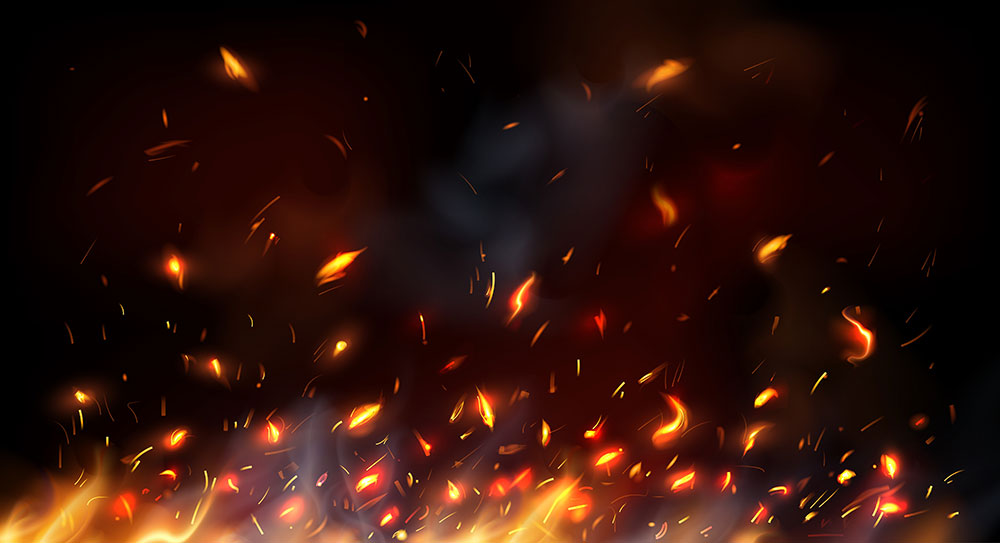Not all fires are created equal. Fires not only start from a variety of means, but they can also burn differently, at various temperatures, and can create varied degrees of damage. As we discussed in a previous blog, there is more to a fire and the damage that it causes than a flame that burns and creates charred remains. Today, we are going to look a little further into the chemistry that is a fire and how that affects house fires and the damage that they cause.
What is Fire?
Technically, a fire is the oxidation process of a particular item during the combustion process. Other oxidation processes include rusting and—something that is probably occurring in your body right now—digestion. Fire is started when an item is exposed to heat beyond its flash point and is able to sustain a rapid rate of oxidation. Fire produces carbon dioxide and other toxic gasses depending on the item or substance being burned; the actual flame of fire is made up of carbon dioxide, oxygen, water vapor, and nitrogen. The color and heat of a fire is dependent on the oxygen available and other fuel.
Anatomy of a Fire
Not all house fires are the same. Though the oxidation process is at a basic understanding the same, the amount of oxygen available, the items burning, and the way in which the fire is put out can create varying degrees of fire and smoke damage.
High & Low Oxygen Fires
Fires with access to higher levels of oxygen tend to have drier smoke and soot which is usually easier to clean up than low-oxygen fires. Low oxygen fires, on the other hand, tend to create high levels of wet, sooty smoke and can be extremely hard to clean up.
Kitchen Fires
Kitchen fires can be one of the hardest fires to clean up after due to all the structures that can be burned such as cabinets, drawers, and appliances. Smoke tends to collect and thus cause more damage behind standing structures and in areas that have cooler temperatures such as drawers and the cabinets themselves. Also, small appliances and other items left on a countertop can create a stain around the item which if not treated soon, will be permanently affixed.
Slow-smoldering Fire
Often, house fires can start with a smoldering fire starter such as a cigarette that is left alone. Smoldering fires usually, have high levels of thick smoke and can have, like other types of fires, deadly fumes in them such as cyanide, carbon monoxide, and carbon dioxide. Slow-smoldering fires can turn into fast-flame fires depending on the time they are left to do their damage and the other substances that the fire comes into contact with.
Fast-flaming Fire
Fast-flaming fires have more flames than smoldering fires and tend to produce lower quantities of smoke. Often these types of fires start with a liquid flammable accelerant and wood, paper, or other highly-flammable materials. A fast-flaming fire is the most common type of house fire.
Other Factors
The way in which a fire burns and the destruction it causes are can be reliant on other factors including the means that is put out: Water-extinguished fires can create humidity levels as high as 100 percent which can subsequently cause water damage. Weather conditions can also affect a house fire.
Why Choose a Fire Damage Restoration Company?
This is not an exhaustive list of the types of house fires or the extend of damage that can occur during a fire. Contacting a professional and experienced fire damage restoration company is incredibly important for many reasons including:
- They know what damage to look for including that which can be hidden
- What must be done to repair and restore your home—no more and no less
- How to safely clean up your home. The soot, left over smoke, ash, and harmful gasses can be deadly if necessary safety precautions are not taken
- The other issues that need to be addressed such as water damage
Choose a fire damage restoration company thoroughly and completely address the damage done and help you pick up the pieces in the easiest and best way possible.
Want to Learn More?
If you have recently been a victim of a fire, contact Bio Star! We have the professional knowledge, experience and tools to help you with the cleanup process after a small or major house fire. Visit our website to learn more about us and our services. Don’t wait! The acidity of smoke and soot left unchecked, can create even more damage after the fire. Call us today!

